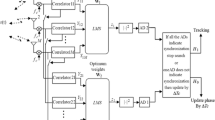Abstract
Multiple-dwell pseudo-noise code acquisition with a noncoherent I-Q detector is analyzed for Rayleigh and Rician fading channels that takes into account the detection correlations resulting from multipath fading. Minimum mean acquisition times with optimized dwell times and thresholds are obtained, and the effects of multipath fading and frequency offsets are evaluated. In addition, a detailed comparison between I-Q and square-law detectors is conducted under various channel conditions.
Similar content being viewed by others
References
U. Cheng, Performance of a class of parallel spread spectrum code acquisition schemes in the presence of data modulation, IEEE Trans. Commun. 36 (May 1988) 596–604.
D.M. DiCarlo and C.L. Weber, Multiple dwell serial search: performance and application to direct sequence code acquisition IEEE Trans. Commun. 31 (May 1983) 650–659.
EIA/TIA-IS95, Mobile station-base station compatibility standard for dual-mode wide-band spread spectrum cellular system (July 1993).
C.W. Helstrom, Calculating error probabilities for intersymbol and co-channel interference, IEEE Trans. Commun. 34 (May 1986) 430–435.
J.K. Holmes, Coherent Spread Spectrum Systems(Wiley, New York, 1982).
J.K. Holmes and C.C. Chen, Acquisition time performance of PN spread-spectrum systems, IEEE Trans. Commun. 25 (August 1977) 778–783.
P.M. Hopkins, A unified analysis of pseudonoise synchronization by envelope correlation, IEEE Trans. Commun. 25 (August 1977) 770–778.
V.M. Jovanovic, Analysis of strategies for serial-search spread spectrum code acquisition-direct approach, IEEE Trans. Commun. 36 (November 1988) 1208–1220.
I. Kanter, Exact detection probability for partially correlated Rayleigh targets, IEEE Trans. Aero. Electron. Syst. 22 (March 1986) 184–195.
H. Meyr and G. Poltzer, Performance analysis for general PN spread spectrum acquisition techniques, IEEE Trans. Commun. 31 (December 1983) 1317–1319.
S.M. Pan, D.E. Dodds and S. Kumar, Acquisition time distribution for spread spectrum receivers, IEEE J. Selected Areas Commun. 8 (June 1990) 800–807.
A. Polydoros and C.L. Weber, A unified approach to serial search spread-spectrum code acquisition-part I: general theory, IEEE Trans. Commun. 32 (May 1984) 542–549.
A. Polydoros and C.L. Weber, A unified approach to serial search spread-spectrum code acquisition-part II: a matched filter receiver, IEEE Trans. Commun. 32 (May 1984) 550–560.
W.-H. Sheen and H.-C. Wang, Sequential detections with applications to PN code acquisition on multipath fading channels, Technical Report NSC–86–2213-E–194–010, National Chung Cheng University (1996).
W.-H. Sheen and S.-G. Wu, Considerations on the performance of serial search pseudo-noise code acquisition with a square-law detector, in: Proc. of 1995 IEEE Vehicular Technology Conference, Chicago, IL (July 26–28, 1995).
W.-H. Sheen and S.-G. Wu, Performance of multiple-dwell directsequence pseudo-noise code acquisition with square-law detector on multipath fading channels, submitted for publication (1996).
M.K. Simon, J.K. Omura, R.A. Scholtz and B.K. Levitt, Spread Spectrum Communications, Vols. I-III (Computer Science Press, MD, 1985).
Y.T. Su, Rapid code acquisition algorithms employing PN matched filters, IEEE Trans. Commun. 36 (June 1988) 724–733.
S. Tantaratana, A.W. Lam and P.J. Vincent, Noncoherent sequential acquisition of PN sequences for DS/SS communications with/without channel fading, IEEE Trans. Commun. 43 (February/March/April 1995) 1738–1745.
A.J. Viterbi, CDMA, Principles of Spread Spectrum Communication(Addison-Wesley, New York, 1995) Chapter 3.
R.B. Ward and K.P. Yiu, Acquisition of PN signals by recursion aided sequential estimation, IEEE Trans. Commun. 25 (August 1977) 784–794.
A. Weinberg, Generalized analysis for the evaluation of search strategy effects on PN acquisition performance, IEEE Trans. Commun. 31 (January 1983) 37–49.
R.E. Ziemer and R.L. Peterson, Digital Communications and Spread Spectrum Systems(Macmillan, New York, 1985).
Author information
Authors and Affiliations
Rights and permissions
About this article
Cite this article
Sheen, WH., Chiou, S. Performance of multiple-dwell pseudo-noise code acquisition with I-Q detector on frequency-nonselective multipath fading channels. Wireless Networks 5, 11–21 (1999). https://doi.org/10.1023/A:1019161919385
Issue Date:
DOI: https://doi.org/10.1023/A:1019161919385




